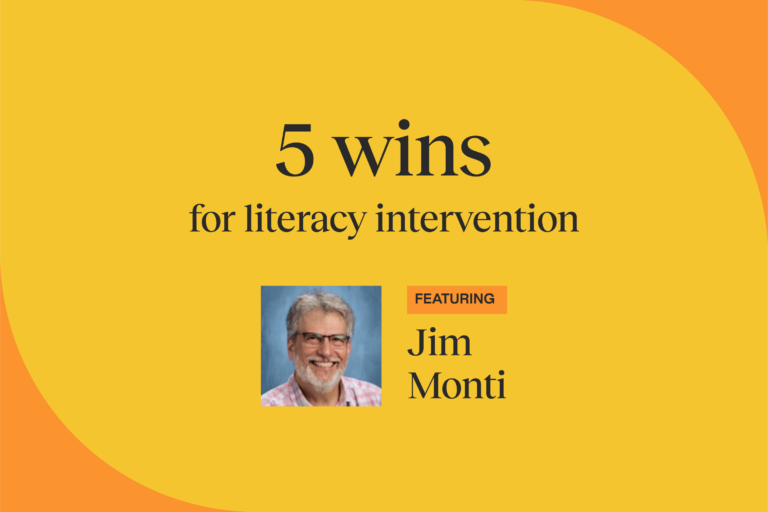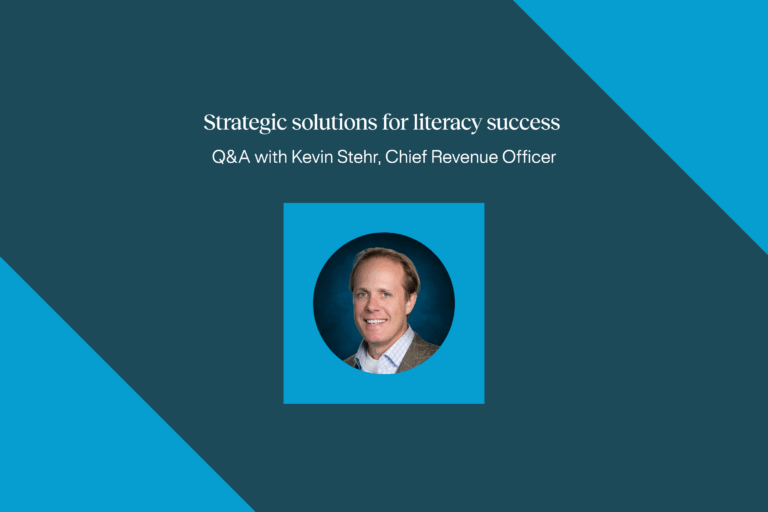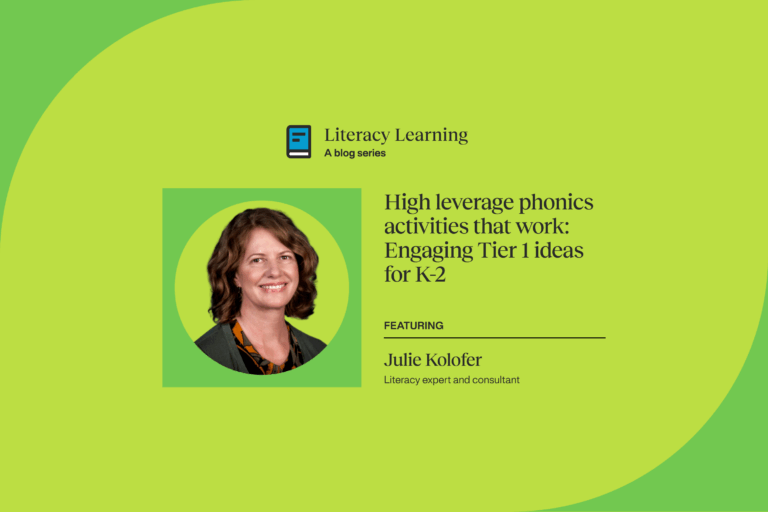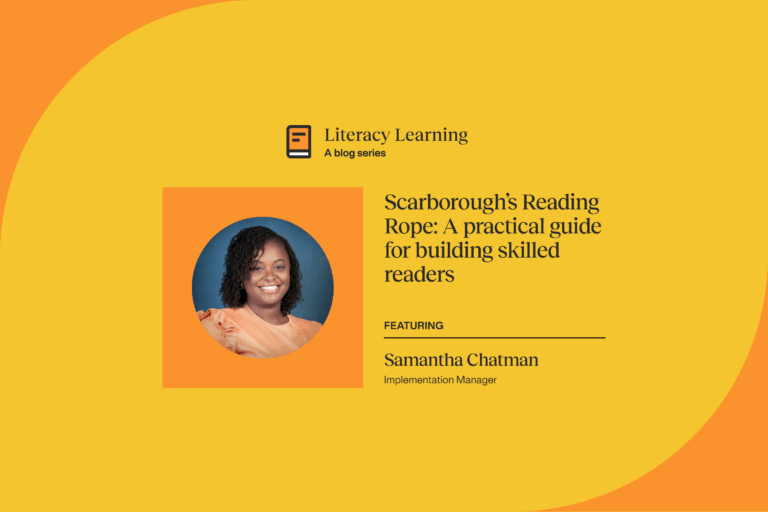Knock down obstacles—get 5 wins for literacy intervention
Discover better intervention with 95 Literacy Intervention System™

95 Literacy Intervention System™ is a comprehensive digital solution designed to effectively diagnose deficits, deliver targeted instruction, and move students out of intervention as soon as possible. West Warwick Public Schools in Rhode Island was an early adopter of 95 Literacy Intervention System. Jim Monti, former Director of Educational Reform, Compliance & Technology at West Warwick Public Schools, shared with us five essential intervention outcomes they achieved by implementing LIS.
I have been waiting for this kind of systemic change in intervention for 30 years!
Jim Monti, former Director of Educational Reform, Compliance & Technology
West Warwick Public Schools District snapshot
- Urban ring community of Providence, Rhode Island
- 23% IEP
- 52% high socio-economic needs
- Students self-identify 78% as White, 9% as Black, 3% as Asian/Pacific Islander, 3% Native American, 7% multi-racial
Jim Monti has been an educator in the West Warwick School System for 36 years, first as a student, and then in various roles from 4th grade teacher to technology specialist to Director of Educational Reform, Compliance & Technology for the last 20 years. Jim led his district in early adoption of 95 Literacy Intervention System as an early innovation partner. They received funding for the implementation of a new Tier 1 curriculum after applying for a Comprehensive Literacy State Development (CLSD) Grant, a federally funded competitive grant that aims to improve literacy skills and development for children from birth through grade 12. The district used ESSER II & III funds to implement a Walk to Intervention Tier 2 program using 95 Phonics Screener Inventory™ (95 PSI™), and 95 Phonics Lesson Library™ (95 PLL™) kits. Recently retired, Jim has been helping 95 Percent Group learn more about his district’s journey and how 95 Literacy Intervention System transformed their Walk to Intervention program.
Four years ago, 55% of students in the district were consistently below readiness level at the start of year. West Warwick Public Schools implemented a new Tier 1 curriculum that had a Tier 2 curriculum “coupled” with it. But the Tier 2 curriculum wasn’t a research-based intervention model. They noticed right away that students were not making the gains expected so they adopted 95 Phonics Screener for Intervention for assessments and 95 Phonics Lesson Library as their evidence-based, all-inclusive Tier 2 intervention program in November of 2022. 95 PSI enabled teachers to quickly diagnose phonemic awareness and phonics skill deficits, and deliver precise intervention right when and where needed—teachers received links that went directly to targeted intervention resources in the 95 Phonics Lesson Library kits.
But they kept coming up against obstacles in their system that prevented them from making the progress they were seeking in their Walk to Intervention program so they set about finding a systems solution. First, they identified what they knew they were doing well. They felt really good about their work screening with 95 PSI. They confirmed they were collecting the right data—what they knew about the students correlated with the data they were getting. And they were comfortable utilizing 95 PLL kits—as Jim explained, “95 PLL was new, but easy to use.”
Their Tier 1 curriculum coupled with the use of 95 PSI and 95 PLL allowed them to see dramatic growth of their students. In fact, after implementing 95 Phonics Screener for Intervention and 95 Phonics Lesson Library, the beginning of year DIBELS data that showed on average 55% of students well below or below benchmark flipped to on average 55% at or above readiness levels by the end of the year.
Then they carefully identified all the weak points in their intervention system—where things could fall apart and why they could fall apart—and set out to solve them. That inventory process helped them to see they needed to streamline the process of going from assessment to the analysis of data, to creating the actual groups, and to implementation of the instruction. That’s where 95 Literacy Intervention System came into the picture—when they compared their obstacles to LIS features, they could see that 95 LIS could mitigate each of the issues.
The district implemented 95 Literacy Intervention System with a large pilot group of educators during the 2023-2024 school year.

Introducing 95 Literacy Intervention System™
Welcome to better intervention. This new digital system is redefining how schools approach intervention management—connecting assessment, precise instruction, and data-driven monitoring—all in one end-to-end solution.
Five key intervention outcomes
In this section, Jim Monti walks us through five intervention outcomes, and how implementing 95 Literacy Intervention System powered West Warwick Public Schools’ transformation.
Outcome #1—Start sooner and stronger with efficient and connected assessment, grouping, and instruction mapping.
The problem
Jim explained how before implementing LIS, West Warwick schools typically lost 3 full months of intervention time at the start of the year. Obstacles they faced included gaps between various data systems. They were dependent on an IT intermediary to manipulate the data. They had scores but no assessment information. They didn’t know what words students were missing in the pseudo words because there was no tool for playback which made grouping more challenging. They lacked a systemic way to progress monitor all the kids in the Walk to Intervention model and see the data transparently. Teachers were burdened with figuring out how to keep and share data.
How LIS provided a solution
“In contrast to the previous years, implementing LIS allowed us to start sooner and start stronger. We launched student intervention groups early in September. We had DIBELS done in the first week, the 95 Phonics Screener for Intervention done the next week, and we were starting protocol meetings right away. With all that, we were able to very, very quickly group our students. Teachers, administrators, and reading specialists were able to hone in on what the groups looked like, and who was going to take each of the different Walk to Intervention groups.
“We didn’t need to waste other resources in the district to do the heavy lifting. We were ready to go and everyone was building on the success of prior years. We could see the strong connections between the groups that we created, the assessments that we gave, and the instruction. LIS allowed us to target kids and get them where they needed to be and the adults that needed to support them. We’ve seen kids in their groupings make tremendous amounts of growth—18-20 weeks worth of growth. When you start seeing that and you can start earlier it means that we’re helping to move all of our kids and accelerate their growth.”
Outcome #2—Gain a 360-degree view into student progress to meet each child where they are.
The problem
Jim shared: “If progress monitoring is solely left up to the educators performing the instruction, then we begin to lose our ability to make data-driven decisions. We fall into the same trap that we’ve always fallen into—we put the responsibility of the data development, gathering, and analysis squarely on the shoulders of the educator. We want our educators to focus on the most important thing, and that’s giving their students high quality instruction. If educators are using all of their cognitive bandwidth on developing a data system and keeping track of student growth, they lose the capacity to just focus on their students.” They needed a system that could give a 360-degree view of each student accessible to all team members, with the system doing the hard work.
How LIS provided a solution
Jim explained: “95 LIS gives us a really deep holistic view—we see the entire child. We see them in terms of where they are starting with us, where their needs are, their unfinished learning, and the progress that they’re making. It really helps us with identifying the students, putting them in the appropriate groups, getting the educator working with them the resources they need, and enabling them to monitor the progress that students are making against the direct structured literacy instruction they’re receiving.”
“LIS helps us keep track of the student progress monitoring data in a structured, systemic manner. This leads to transparency and allows support personnel in the building (reading specialists, reading coaches, building administrators, and central office administrators) the opportunity to roll up their sleeves and provide meaningful assistance to students and educators. Instead of asking educators if they’re progress monitoring students, they can say things like, ‘I noticed that Lisa isn’t making the same type of progress as other students in her group. Is there anything that I can do to help you with Lisa?’ Everyone now can see and focus on what each unique child needs.
“I think that a 360° view into student progress helps us actually do what we want to do, and that’s to give the right interventions to kids and the right support because it supports the educator as well as the student.”
Outcome #3—Empower data-driven decision-making at the classroom, school, and district level.
The problem
West Warwick knew that their educators should be making data-driven decisions. But what that meant was never fully addressed. Teachers needed to know more—What data? How do we analyze it? Who can help me? Am I on my own here? Do I need to forge my own path? When do I do this? The districts tried to teach educators how to collect and use various data tools. Often teachers were asked to do this work in compressed PD sessions where the mechanics were taught but there wasn’t enough follow-up or just-in-time teaching and learning. As Jim told us, “Of course we weren’t successful. En masse we could never say that our educators were making data-driven decisions about their students…We said not only do you have to make data-driven decisions, but you have to develop a system to do that. You have to figure out what data to look at, and then you have to put it in a manner where you can do some analysis from it. It takes so much cognitive bandwidth for that kind of conversation. And when you don’t have the right information, you start making assumptions about what the issues are.”
How LIS provided a solution
“95 LIS has helped us answer all the questions asked earlier. What data? How do we analyze it? Who can help me? Am I on my own here? Do I need to forge my own path? When do I do this? All of those questions, or let’s be honest—obstacles—were eliminated from the process. 95 LIS allowed for data-driven decisions at the classroom level, the grade/school level, and at the district level.
“Everyone can see now what we’re progress monitoring. We’re not comparing apples to oranges. We’re all saying ‘Here’s what we’re using for a progress monitoring tool. Here’s the data that we’re collecting. Here’s where we’re going to put it.’ As an administrator, I can look at that information and I can go to Barbara and say, ‘Barbara, I’ve noticed all of your kids are really growing at a pretty tremendous rate, good work for all of you. We can see that the instruction that you’re giving is having an impact on the students. But I noticed that Jim is not progressing at the same rate as everyone else. Is there a way that I can help you? Is there something I can do?’ And Barbara might say to me ‘Well, Jim doesn’t come to school.’
“Then I can meet with a parent who I’ve already spoken to and said, ‘You really need to get Jim to school.’ But now I get to sit down with them and say ‘I want to show you something. I want to show you the growth that kids like Jim have made who are coming to school all the time and then I want to show you Jim’s growth. There’s a big difference between those and the only thing that I can see that’s getting in the way is Jim is not coming to school as often as the other kids. Is there something we can do to help with that?’ That changes the conversation. When we can target the issue, then we can actually offer really valid assistance versus just making everyone feel bad.”
Outcome #4—Realize your highest goals for student growth and classrooms full of joyful readers.
The problem
West Warkwick’s highest goal for students is for them to develop into fully literate beings with the agency to follow their passion and dreams, and have access to all of the opportunities that students in more affluent communities have. Fulfilling that vision requires understanding the data behind students’ reading progress. Jim explained that before implementing LIS, they used a shotgun approach—they just shot interventions into the ether, and hoped that kids got something out of it. It wasn’t targeted. They knew it needed to be, but they didn’t have the right diagnostic tools to even find out what kids needed. They had been trying to do a Walk to Intervention model for years in the district but just didn’t have all of the right pieces in place. This puts a lot of pressure on teachers. As Jim described, “Teachers were actually trying to run three different groups in an hour block just to match up with what students needed in that grouping. We shuffled kids around and we put kids that we thought needed the right things together.”
How LIS provided a solution
“When you identify the students correctly and you pair them up with the educator, and you give the educator the right resources, everything changes. Teachers have told us, ‘My favorite time of the day is during our Walk to Intervention time because I know I’m going to be successful with my kids and I know they’re going to be successful.’
“With the right diagnostic tools now, we are able to say, ‘Oh, all of these kids need short vowel sounds! How many kids do we have?’ And they have the resources at hand that they need to teach exactly what those kids need.
“Years ago in the ’90s, we talked about the principles of learning and one of the principles is celebration of accomplishment. When kids and teachers are being successful at the work that they’re doing, they feel good about that, and that’s a true celebration of that accomplishment. So when I say to a kid, “I can’t believe that you’ve got that silent E sound after we’ve been working on it for four days now. That’s incredible. That’s amazing that you’ve got that now. That’s in your hip pocket. You’re always going to own that.” That builds that joy and that builds success on top of success.”
Outcome #5—Reduce busywork, build trust—and step into the leadership role you’ve always envisioned.
The problem
The success for the students never matched the efforts the educators were applying. Jim describes their efforts as “scattered and full of great intentions; but student success always seemed marginal at best…we weren’t collecting the right data or people were collecting different data points and it was up to individual teachers, so there wasn’t a lot of transparency regarding that. When we started to bring people together, we were having some pretty challenging conversations about data.”
How LIS provided a solution
Jim explained: “95 LIS created a transparent and efficient system that allowed us to be laser-focused with our reading intervention. When data is available to everyone, transparency builds trust. When we all can review the data in a collaborative environment, we problem solve our solutions. These collaborative conversations centered on our students’ reading goals build respect and rapport among educators. And when we engage in focused discussions and build on collaborative respectful dialog, we build educational leaders. It’s not about who has the loudest voice in the room. It’s about understanding what the data tells us, identifying what resources we have available, and finally what difficult decisions we need to make.
“This work builds trust and a structure that allows educators and students to be successful. Instead of feeling tricked by our hope, we get to build upon it. Eventually, we just trust that it will always be there. Teachers have learned that their principals have their back because they’re doing the work of rolling up their sleeves and doing this grouping with them. They’re not asking them to come up with it by themselves. It’s really a collaborative process so now, no one is saying to me, ‘Just giving the PSI is busywork,’ because it has a different impact on outcomes. They don’t see those things as disjointed. They see them as really connected so it ends up creating an environment where there is true respect and rapport for each other, because all of those other obstacles are taken out of the way.
“I just retired and all of our elementary school principals came up to me individually and were grateful that they have the opportunity to be an educational leader with their colleagues in their building—that builds grace with each other. It really does. One principal told me, ‘Finally, I can be the leader I’ve always wanted to be now that I don’t have to keep having these grouping and regrouping discussions…I can go ahead and lead.’”
Watch the on-demand webinar now
Encountering systemwide challenges with your literacy intervention program? Watch our on-demand webinar, Knocking Down Obstacles to Drive Literacy Gains, featuring Jim Monti—former Director of Educational Reform, Compliance & Technology at West Warwick Public Schools.
In this webinar, Jim shares insights from his district’s experience and explores the 5 critical intervention outcomes you can expect from the 95 Literacy Intervention System™. Catch it now on YouTube and discover strategies to overcome literacy obstacles!



